JWJ Guitars Parlour and Orchestra review
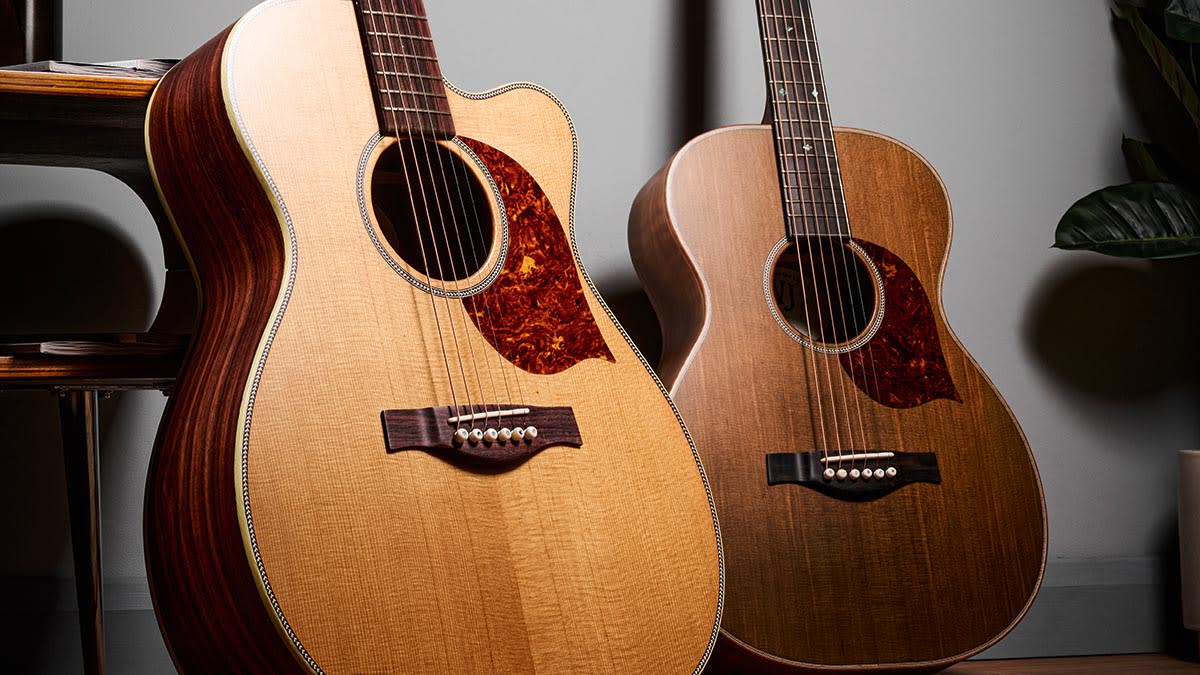
We have to admit that we weren’t aware of JWJ Guitars until a few months ago when luthier Rich Jones visited us at Guitarist HQ in order for us to sample his wares. Based in Shropshire, Jones began building guitars as a hobbyist 20 years ago, turning fully professional around 2018.
With guitars a passion since his youth, Jones had found that his early builds were attracting a lot of attention in his local music scene, with players queuing up for new instruments.
Eventually, the decision was made to make guitar building his full-time occupation. “I was running a restaurant,” he tells us. “I’d always run pubs and restaurants and it was just hard work, doing all those hours and never being at home. So it just kind of made sense to do this and be around more, you know?”
Essentially a one-man operation, Jones now builds a range of acoustic guitars and will happily take on the individual design requirements of his customers.
Both the models we have before us now are recent builds and two contrasting guitars: the ever popular OM-size cutaway, plus a Parlour/00 – both of which are finished in a thin matt coating of nitrocellulose.
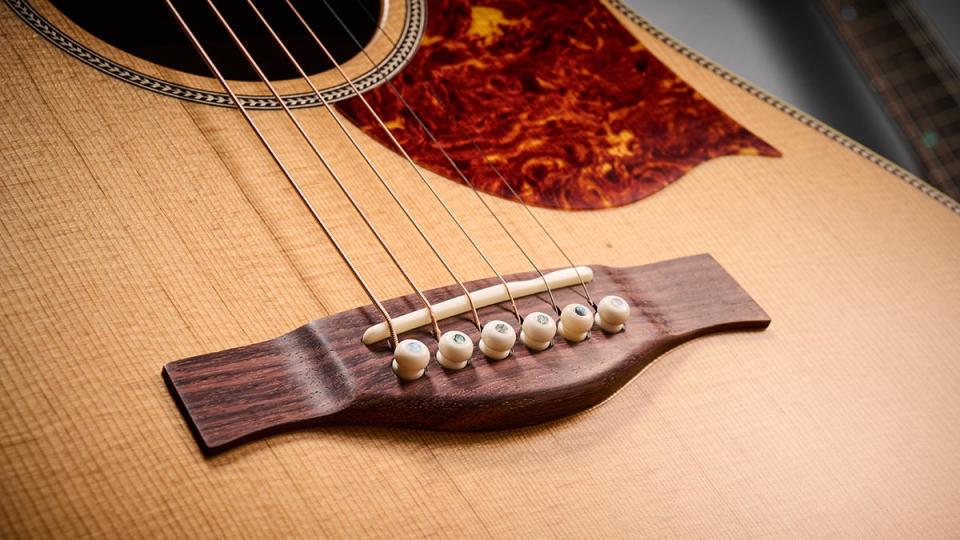
Our first glance suggests a very high level of workmanship on both instruments and Jones tells us that both have been built using only hand tools and workbench hours. We’re quite excited to pick them up and start hearing their voices, but first, a quick run-through of the duo’s parts and specs.
Looking first at the Parlour model, despite its name, it measures up more as an 00, as it lacks that petite ‘figure of eight’ shape to the body. Here, the lower bout is slightly more full and rounded.
The top is what Jones has described as “aged cedar,” whereby the wood is vacuum-dried before the ageing process is begun using ammonia gas, which reacts with the tannins in the wood to produce the distinctive ‘antiqued’ appearance we see here. It certainly has a much darker look to it than cedar’s usual ruddy hue.
Back and sides are from a nicely bookmatched and very attractive figured walnut that bounces around in the light as the guitar shifts position (a phenomenon known to luthiers as chatoyance). The neck is Honduran mahogany – another premium wood – topped with an African mahogany fretboard, and the same wood is used in the guitar’s bridge. Both the nut and saddle are from bone, and the slotted headstock and Kluson tuners complete the package.
Our first glance suggests a very high level of workmanship on both instruments
You might have noticed that the Parlour’s neck joins the body at the 13th fret instead of the more customary 12th or 14th. Naturally, we were curious as to the thought process behind this: “A lot of builders say that a 12th-fret join sounds best, don’t they?” says Jones. “So it was a kind of a compromise really, because whenever I played 12-fret [to the body] guitars – and I don’t play at the top a great deal – even I kind of miss that accessibility.
“Whereas the 13th-fret joint, I feel like I can still play most of the things that I want to play fairly easily. And you move the bridge just a little bit further towards the widest part of the top. I wanted to make sure that I still had that bottom-end and volume.”
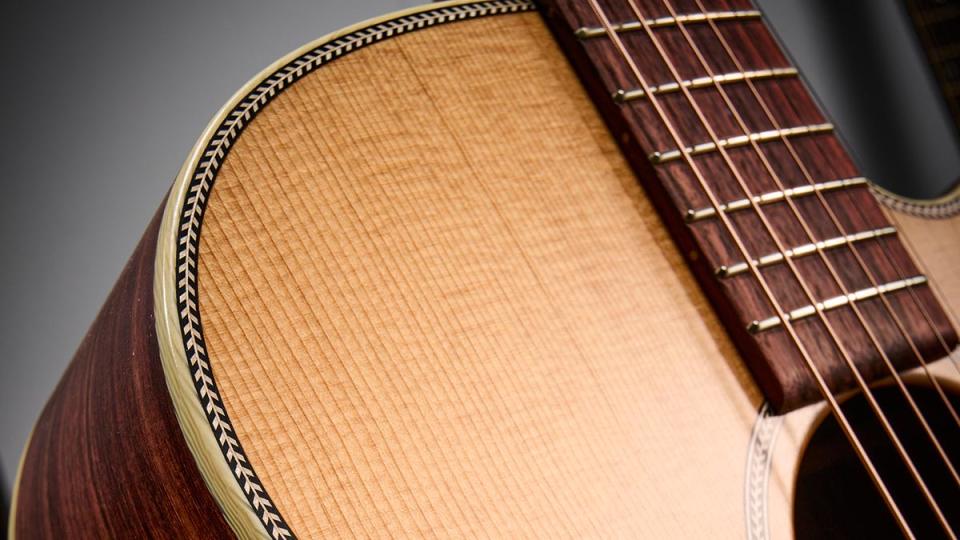
All fair enough, of course, and it made us think why the 12th and 14th neck joint has become so firmly traditional in the acoustic world. Martin’s SC-13E acoustic also has a 13th-fret neck joint and so maybe it’s time to re-evaluate things? In any case, it all comes down to tone and we’ll be auditioning the Parlour shortly. But first we’ll turn our attention to the OM.
Once again, just turning the guitar over in our hands, it’s easy to see the quality of the workmanship that has gone into this build. Binding, bookmatching, fretwork and finishing are all top-notch. The soundboard is torrefied Sitka spruce with the back and sides made from Indian rosewood.
The neck is Honduran mahogany with an Indian rosewood ’board, headstock faceplate and bridge. Once again, both the nut and saddle are bone and a set of Kluson open-back 18:1 ratio tuners completes the body furniture.
Feel & Sounds
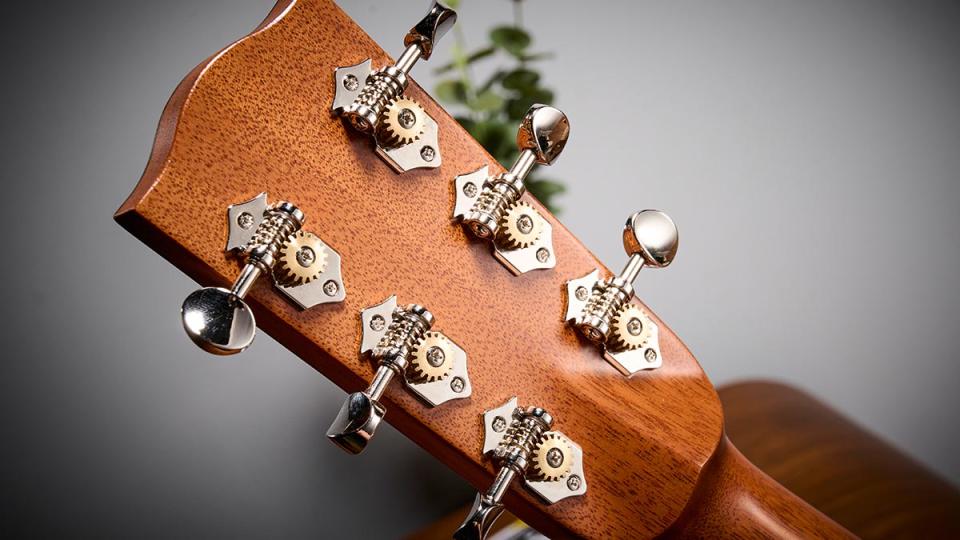
One thing that both guitars have in common is that they are really light. It’s the first thing you notice when you pick them up.
“I like to make them as resonant as possible,” Jones tells us. “The lightness is something that a lot of people comment on when they pick them up and I think the lighter build helps the resonance, really. If I pick up an electric now it just feels like an anvil!”
Returning to the Parlour, we’re surprised by how loud it is and it’s certainly not lacking in the bass end. Many small-bodied acoustics tend to suffer from boxiness, but there isn’t a trace of that present here.
It’s likely that the combination of the lighter build and the 13th-fret neck joint having moved the bridge in a little more has made a considerable amount of difference. And, as far as orientation is concerned, the neck joint wasn’t a problem for us at any point while we were putting the Parlour through its paces.
In both instances we have to factor in that these guitars are workbench-fresh, and it will be a while before the woods settle in and the tops open out. But what we’ve heard so far certainly bodes well for the future. If we were going to be really picky, we would say that there is a little bit of midrange mud around the E on the Parlour’s D string, but it’s very slight and could easily be put down to the settling in process that we’ve just noted.
The OM is everything you’d expect from this most popular body size. Basses, mids and trebles are all nicely balanced and there’s a good set of dynamics present, too. Played lightly, it whispers – and just stops short of a full-blooded roar when strummed or picked hard. After all, if ‘roar’ is your thing, you’d probably be looking at a dreadnought anyway.
The neck is a full C shape – quite chunky and pleasantly so to boot – and playability is great across the fingerboard, with the finely crafted cutaway offering access to the uppermost frets.
Verdict
We like both of these guitars a lot. Each has its own particular charm. The Parlour is slight in body and big in voice, it looks great, the build quality is very good and that aged cedar top sets the guitar off well. The OM is more the all-rounder with plenty of volume and a good dynamic range.
In terms of price, when you consider that both of these instruments are hand-crafted, nitro-finished with premium body woods, and weigh in at under £2k, they really are competitive in today’s acoustic marketplace and well worth checking out. We would definitely conclude that JWJ Guitars is a name to watch.
Specs – JWJ Guitars Orchestra
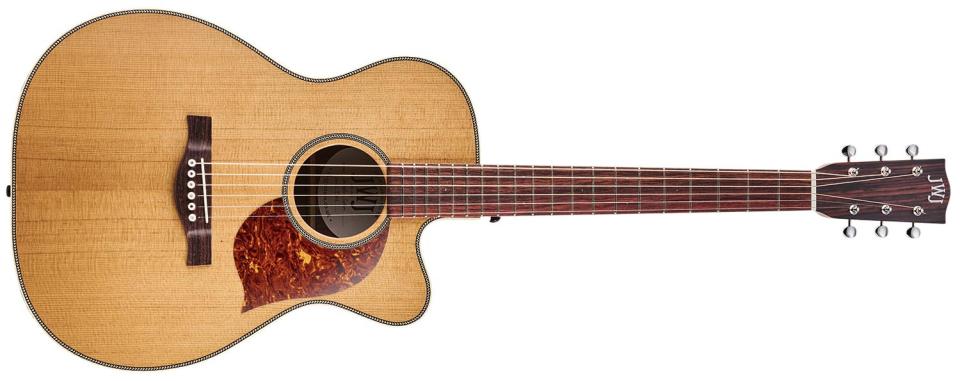
PRICE: £1,975 (inc Hiscox case)
ORIGIN: UK
TYPE: 00-size acoustic
TOP: Aged cedar
BACK/SIDES: Figured European walnut
MAX RIM DEPTH: 105mm
MAX BODY WIDTH: 363mm
NECK: Honduran mahogany
SCALE LENGTH: 632mm (24.9”)
TUNERS: Kluson open-back 18:1 ratio
NUT/WIDTH: Bone/44mm
FINGERBOARD: African ebony
FRETS: 19
BRIDGE/SPACING: Bone/57mm
WEIGHT (kg/lb): 1.59/3.52
OPTIONS: LR Baggs Lyric or James May Ultra Tonic pickups installed – both £300
RANGE OPTIONS: Custom builds available from £1,999. Parlour, Orchestra, Dreadnought and Slope Shoulder models, C, D, V or A neck profiles, a range of tonewoods and aesthetic options available
LEFT-HANDERS: Yes, no upcharge
FINISH: Satin nitrocellulose
Specs – JWJ Guitars Parlour
PRICE: £1,875 (inc Hiscox case)
ORIGIN: UK
TYPE: OM-size acoustic
TOP: Torrefied Sitka Spruce
BACK/SIDES: Indian Rosewood
MAX RIM DEPTH: 110mm
MAX BODY WIDTH: 382mm
NECK: Honduran mahogany
SCALE LENGTH: 644mm (25.4”)
TUNERS: Kluson open back 18:1 ratio
NUT/WIDTH: Bone/43.5mm
FINGERBOARD: Indian rosewood
FRETS: 20
BRIDGE/SPACING: Bone/57mm
WEIGHT (kg/lb): 1.6/3.6
OPTIONS: LR Baggs Lyric or James May Ultra Tonic pickups installed – both £300
RANGE OPTIONS: As left, prices from £1,999, cutaway is a £125 upcharge
LEFT-HANDERS: Yes, no upcharge
FINISH: Satin Nitrocellulose
CONTACT: JWJ Guitars

